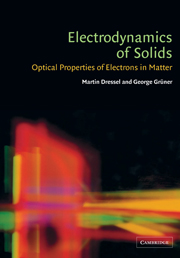8 - Techniques: general considerations
Published online by Cambridge University Press: 20 May 2010
Summary
The purpose of spectroscopy as applied to solid state physics is the investigation of the (complex) response as a function of wavevector and energy; here, in the spirit of optical spectroscopy, however, we limit ourselves to the response sampled at the zero wavevector, q=0 limit. Any spectroscopic system contains four major components: a radiation source, the sample or device under test, a detector, and some mechanism to select, to change, and to measure the frequency of the applied electromagnetic radiation. First we deal with the various energy scales of interest. Then we comment on the complex response and the requirements placed on the measured optical parameters. In the following sections we discuss how electromagnetic radiation can be generated, detected, and characterized; finally we give an overview of the experimental principles.
Energy scales
Charge excitations which are examined by optical methods span an enormous spectral range in solids. The single-particle energy scales of common metals such as aluminum – the bandwidth W, the Fermi energy εF, together with the plasma frequency ħωp – all fall into the 1–10 eV energy range, corresponding to the visible and ultraviolet parts of the spectrum of electromagnetic radiation. In band semiconductors like germanium, the bandwidth and the plasma frequency are similar to values which are found in simple metals; the single-particle bandgap εg ranges from 10−1 eV to 5 eV as we go from small bandgap semiconductors, such as InSb, to insulators, such as diamond.
- Type
- Chapter
- Information
- Electrodynamics of SolidsOptical Properties of Electrons in Matter, pp. 207 - 216Publisher: Cambridge University PressPrint publication year: 2002



